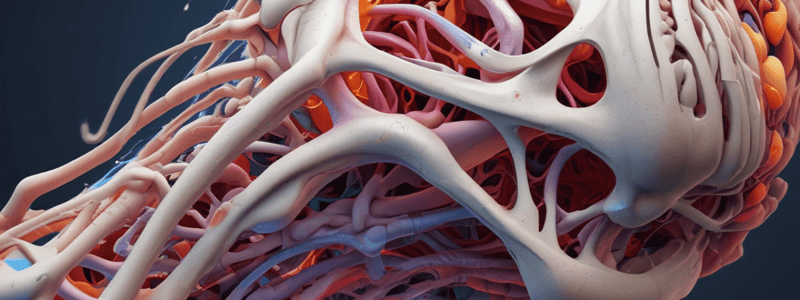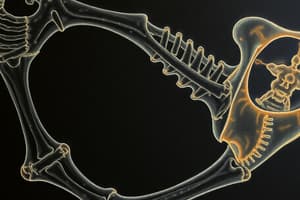Podcast
Questions and Answers
Which of the following statements best describes the mechanical behavior of cortical bone under tensile load in the transverse direction?
Which of the following statements best describes the mechanical behavior of cortical bone under tensile load in the transverse direction?
- Cortical bone has higher strength and toughness in the transverse direction.
- Cortical bone is most brittle and exhibits minimal plastic deformation. (correct)
- Cortical bone has equal mechanical properties in tension and compression.
- Cortical bone is most ductile and exhibits significant plastic deformation.
How does the mechanical behavior of trabecular bone differ from cortical bone?
How does the mechanical behavior of trabecular bone differ from cortical bone?
- Trabecular bone is more susceptible to fatigue failure compared to the more brittle cortical bone.
- Trabecular bone has equal mechanical properties in all directions, unlike the anisotropic behavior of cortical bone.
- Trabecular bone has higher stiffness and strength but lower toughness compared to cortical bone.
- Trabecular bone has lower stiffness and strength but higher toughness compared to cortical bone. (correct)
How does the distribution of stress differ between compressive and tensile loads on a bone under bending?
How does the distribution of stress differ between compressive and tensile loads on a bone under bending?
- The stress distribution is higher in tension compared to compression. (correct)
- The stress distribution is uniform throughout the bone cross-section.
- The stress distribution is linearly proportional to the distance from the neutral axis.
- The stress distribution is higher in compression compared to tension.
How does the rate of loading affect the mechanical properties of bone tissue?
How does the rate of loading affect the mechanical properties of bone tissue?
What is the clinical relevance of understanding the mechanical properties of bone tissue?
What is the clinical relevance of understanding the mechanical properties of bone tissue?
What is the primary function of the organic matrix in bone?
What is the primary function of the organic matrix in bone?
What is the primary role of the non-collagenous matrix proteins in bone?
What is the primary role of the non-collagenous matrix proteins in bone?
Which of the following is the most accurate description of the hierarchical structure of bone?
Which of the following is the most accurate description of the hierarchical structure of bone?
Which of the following is a key mechanical property of the healthy bone tissue?
Which of the following is a key mechanical property of the healthy bone tissue?
Which of the following is a common mode of mechanical failure in bone tissue?
Which of the following is a common mode of mechanical failure in bone tissue?
What is the primary organic component of bone tissue?
What is the primary organic component of bone tissue?
Which of the following is NOT a characteristic of trabecular bone?
Which of the following is NOT a characteristic of trabecular bone?
Which of the following mechanical properties is NOT exhibited by bone tissue?
Which of the following mechanical properties is NOT exhibited by bone tissue?
What is the primary mode of mechanical failure in bone tissue?
What is the primary mode of mechanical failure in bone tissue?
Which of the following conditions is associated with altered bone mechanical properties?
Which of the following conditions is associated with altered bone mechanical properties?
Flashcards are hidden until you start studying
Study Notes
Bone Mechanical Characteristics
- Bone exhibits nonlinear elastic behavior with a moderate plastic region
- Mechanical characteristics vary according to:
- Geometry
- Load mode applied
- Direction of load
- Rate of loading
- Frequency of loading
Cortical Bone
- Cortical bone is most brittle under tensile forces in the transverse direction
- It is tougher and stronger in compression
Trabecular Bone
- Can absorb considerable energy while maintaining a minimum mass
Anisotropic Behavior
- Bone exhibits different mechanical properties when loaded along different axes
- Stiffer and more plastic in one direction, less stiff and no plasticity in another direction
Bending Load
- Compression and tension stress not equally distributed, increased magnitude farther from neutral axis
Torsional Load
- Twist about an axis, shear stress developed, magnitude of stress proportional to distance from axis
Rate Dependency: Viscoelasticity
- Increased loading rate, increased stiffness, increased load
- Loading rate influences the fracture pattern and soft tissue damage
Reduced Load Effect on Bone
- Immobilized for 60 days, bed rest reduces bone mass by 1%/wk
Material Composition
Organic Matrix (~40% dw)
- Type I collagen (90%)
- Proteoglycans
- Non-collagenous matrix proteins
- Amorphous ground substance
Inorganic Matrix (~60% dw)
- Calcium hydroxyapatite, provides compressive strength to bone
Microstructure
- Seven hierarchical levels:
- Isolated crystals & collagen fibrils
- Mineralized collagen fibril
- Mineralized fibril array
- Fibril array patterns
- Single osteon
- Spongy and compact bone
- Whole bone
Studying That Suits You
Use AI to generate personalized quizzes and flashcards to suit your learning preferences.




